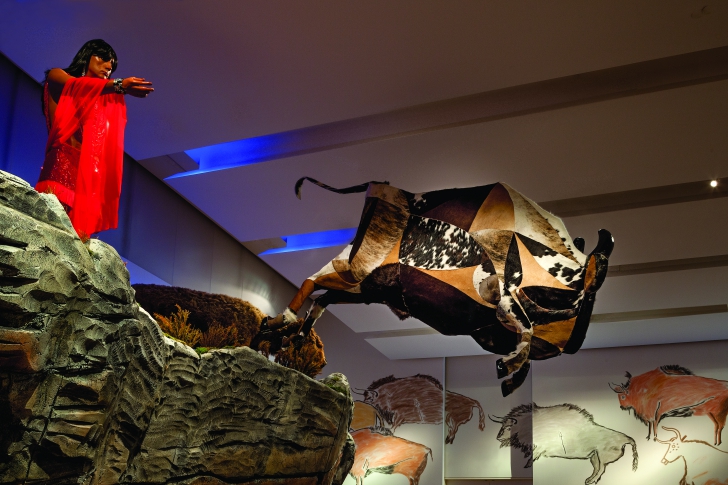The annual school field trip to a museum is an essential element of nearly every Canadian childhood. While paintings, shards of pottery and life-sized fibreglass sharks can be entertaining, the museum diorama is what really captures the imagination of many kids. The three-dimensional installations, usually rendered life-sized, have been popping up in institutions since the late 19th century, depicting Mesozoic landscapes populated by dinosaurs or groups of Neanderthal’s carving stone tools.
But while the diorama has provided kids with a means to envision history, it’s also frequently troubling in its representation of Indigenous and non-Western cultures. Complex civilizations are reduced to single, often inaccurate, images of plastic people, draped in fur and feathers, huddled around fires or waving tomahawks.

Artist Kent Monkman often examines the ways First Nations people are represented, both in museums and in European artistic traditions. The idiom of the diorama has popped up in his work multiple times over the years. 2012’s Two Kindred Spirits put a queer spin on the Lone Ranger and his Aboriginal sidekick Tonto. 2014’s Bête Noire saw his drag alter-ego Miss Chief Eagle Testicle slay a Cubist bull with pink arrows from her motorcycle. Raised in Winnipeg, Monkman’s first encounter with dioramas happened when he was around eight years old, during a trip to the Manitoba Museum (then known as the Museum of Man and Nature).

“I remember they were kind of amazing in their scale but I also noticed this disconnect between how First Nations people were represented in the museum and what was actually happening outside on the streets,” he recalls. “We were being presented with this sort of frozen in time, pre-contact image that’s supposed to represent our culture and then you walk outside and see Aboriginal people falling out of bars, drunk on the street. For me, that was a very visceral experience of these two paradigms, having the museum choosing to represent First Nations cultures in this way next to the actual fall out of colonization on the street.”

For his exhibition with the Gardiner Museum as part of ImagineNATIVE, Monkman continues this exploration with The Rise and Fall of Civilization, a large-scale installation featuring Miss Chief perched atop a nine-foot “buffalo jump”. Next to her stand two mounted bison that leap from the cliff, morphing through several Cubist forms, ultimately appearing on the walls as Aboriginal rock pictographs. Inspired in part by the museum’s collection of bone china, the base of the cliff is littered with smashed ceramics, a reference to both the bones found at buffalo jumps and the history of Indigenous ceramics at sites across North America.
His incorporation of Cubism in this and other works is part of an ongoing investigation into the way European artistic traditions have been viewed and influenced by Aboriginal art and cultures. (Picasso’s “invention” of the form was based largely on his borrowing of African aesthetic forms.)

“It’s a riff on these kind of flattened, deconstructed pictorial spaces artists like Picasso worked with as a metaphor for the last 150 years of modernity and their compression and flattening of Indigenous cultures,” Monkman says. “There’s also a reference to the idea of how European modernists really extracted influence from Indigenous cultures that they deemed primitive. It’s not so much about appropriation. That’s been dealt with a lot before. It’s more about how Modernism produced that philosophy of wilful amnesia that’s been very damaging to First People’s where our own languages and cultures were sort of stripped from us.”
Monkman’s dual identities as queer and Aboriginal filter through many of his works; from muscular Cree men spanking submissive Mounties, to cowboys and indians engaged in woodland circle jerks, to Miss Chief’s gender-queer fabulousity. Rather than a simple front and centre take on identity politics, his use of this imagery points to the fact many First Nations cultures celebrated queer and trans people.
“I like to talk about that because a lot of people are unaware that there was acceptance and respect and reverence for the people that were gay or lesbian, that existed in our cultures pre-contact,” he says. “The experience of colonization stripped away so many aspects of our cultures and this was one aspect that got repressed and denied and misunderstood, largely with the influence of government and church policies. So for the average gay person, I want them to know that we had that acceptance. It’s just one aspect of our cultures that was reduced through this period of colonization.”
(The Rise and Fall of Civilization
Thursday, Oct 15, 2015–Sunday, Jan 10, 2016
Gardiner Museum, 111 Queens Park, Toronto
imaginenative.org
All photos taken by Jimmy Limit.)


 Why you can trust Xtra
Why you can trust Xtra


